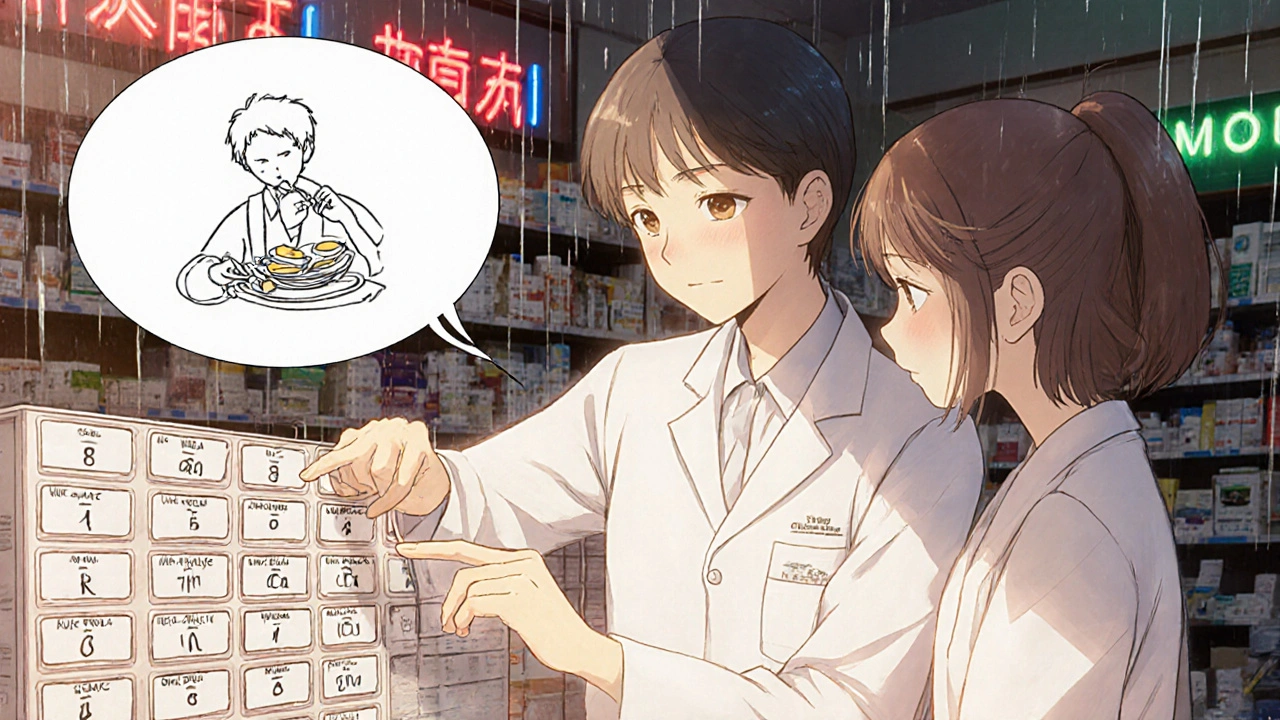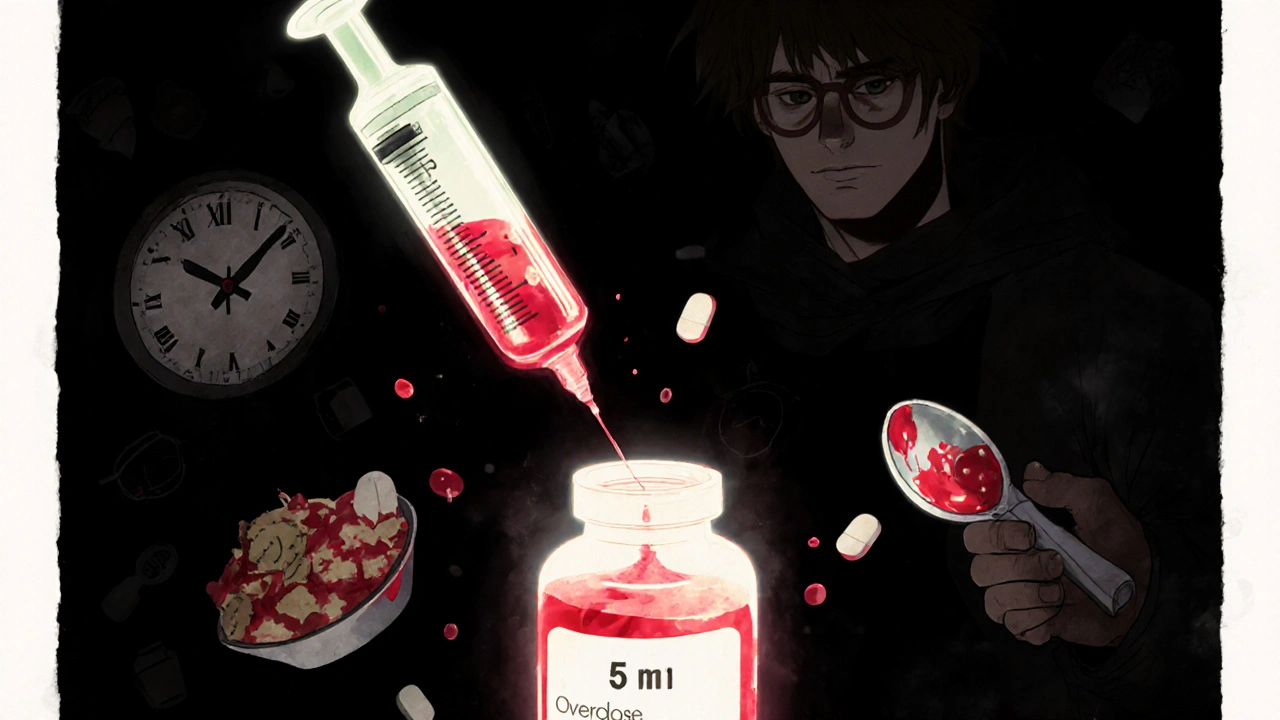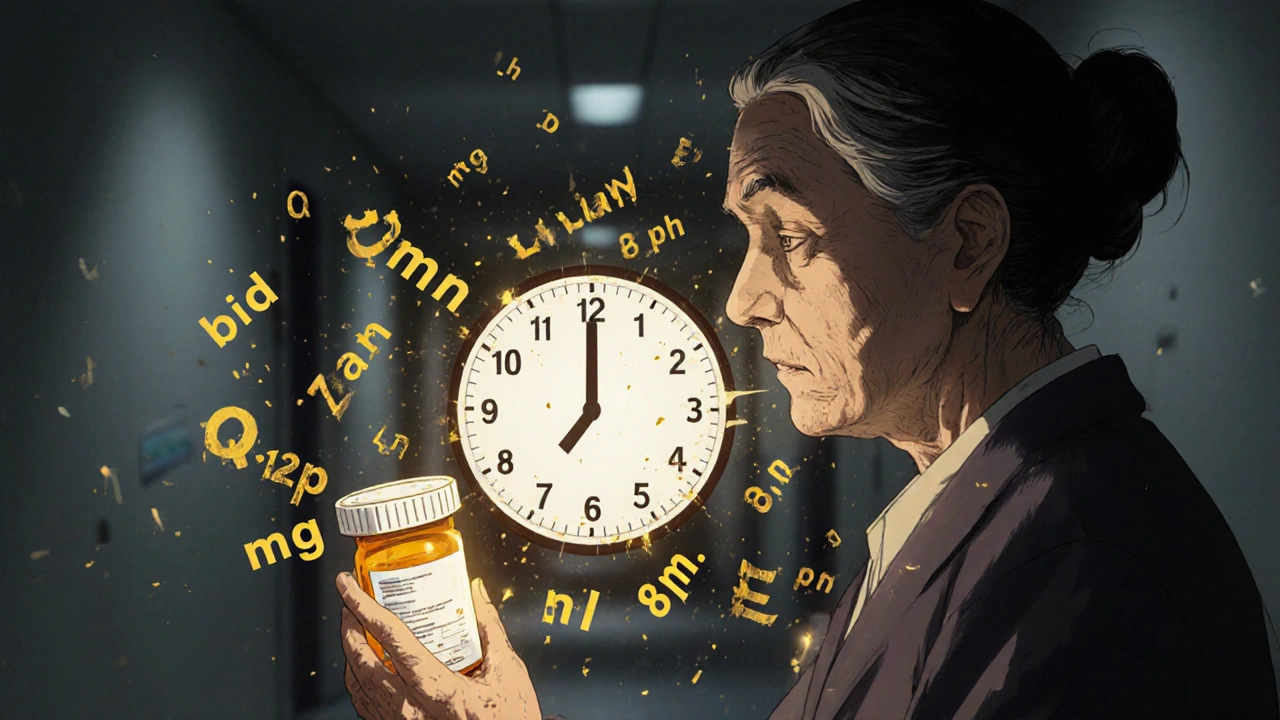Medication Dosing Time Calculator
This tool helps you convert common medication instructions into specific dosing times to avoid confusion and medication errors.
Your Medication Schedule
Every year, over 1.3 million people in the U.S. suffer medication errors because they didn’t understand what their prescription meant. It’s not because they’re careless. It’s because the labels are written in a language most people can’t read-literally. You might think you know how to read a pill bottle: ‘Take one tablet twice daily.’ But what does that really mean? When is ‘twice daily’? Morning and night? Or 8 a.m. and 4 p.m.? And if you’re taking five different meds, how do you keep track? This isn’t just confusing-it’s dangerous.
Why Medication Labels Are Hard to Understand
Most prescription labels are written at a 10th-grade reading level. The average adult reads at a 6th- to 8th-grade level. That mismatch isn’t an accident-it’s the system. Labels use terms like ‘bid’ or ‘q12h’ that even some nurses don’t use in everyday talk. A 2009 study found that 47% of patients misunderstood instructions like ‘take twice daily.’ But when the same label said, ‘Take one tablet in the morning and one tablet in the evening,’ comprehension jumped by 15-20%. Even simple words trip people up. ‘Take with food’ doesn’t tell you if you should eat before, during, or after. ‘Take as needed’ leaves people wondering: needed for what? How many times is too many? One patient told researchers she thought ‘take every 4-6 hours’ meant she could take 4 to 6 pills at once. That’s not a mistake-it’s a design flaw. And then there’s the numbers. Mixing up mg and ml is one of the most common-and deadly-errors. A parent giving liquid medicine to a child might think ‘5 mL twice daily’ means 5 mL total, not 5 mL each time. In one study, 63% of children’s medicine labels used confusing charts instead of clear numbers. Only 8% used pictures. That’s why nearly half of all caregivers make dosing mistakes with kids’ meds.What Works: The Proven Strategies
There’s a better way. And it’s not just about writing simpler words. It’s about changing the whole design. The Universal Medication Schedule (UMS) is one of the most effective tools. Instead of ‘take twice daily,’ labels now say: morning, noon, evening, bedtime. This matches how people actually live. A 2022 study in Wisconsin found that switching to UMS cut dosing confusion by 47% among older adults on multiple medications. One 72-year-old patient said, ‘I finally understood when to take my pills.’ Visuals matter too. Pictograms-simple drawings showing a person taking a pill with food, or a clock showing morning and night-boost correct understanding by 28% for people with low literacy. The U.S. Pharmacopeia (USP) now requires these on all new prescription labels by May 2025. No more guessing what a tiny icon means. Another key strategy is the teach-back method. Instead of just handing over a bottle, the pharmacist or nurse asks: ‘Can you tell me how you’ll take this?’ If the patient says, ‘I’ll take two when I feel pain,’ they’ve misunderstood. But if they say, ‘One in the morning, one at night, no more than that,’ they’ve got it. Studies show this simple conversation cuts misunderstanding by 33%.What Doesn’t Work
Simplifying the words alone isn’t enough. A 2013 study tested ‘patient-centered labels’-clearer wording, bigger fonts, bullet points. It worked for one thing: preventing people from taking too much in a single day. But it didn’t stop them from taking pills too close together, or doubling doses because they thought ‘twice daily’ and ‘every 12 hours’ meant the same thing. That’s a big problem. People still got it wrong-just in different ways. And not all pharmacies are on the same page. One patient in a CDC focus group said, ‘Every pharmacy uses different words for the same thing.’ One says ‘take with meals,’ another says ‘take during food.’ You can’t trust consistency. That’s why standardized rules are needed across all systems.
How to Protect Yourself and Your Family
You don’t have to wait for the system to fix itself. Here’s what you can do today:- Ask for plain language. Say: ‘Can you explain this in simple terms?’ or ‘Can you show me how to take this?’
- Use a pill organizer. Fill it with the day and time, not just ‘morning’ and ‘night.’ Write the actual times: 8 a.m., 8 p.m.
- Take a picture of the label. Keep it on your phone. When in doubt, check it.
- Ask about pictograms. If your label doesn’t have them, ask if they’re available. Many pharmacies can print them.
- Double-check liquid doses. Use the dosing cup that came with the medicine-not a kitchen spoon. A tablespoon is not 5 mL. It’s 15 mL. That’s three times too much.
- Teach-back your own instructions. If you’re giving medicine to a child or elderly parent, ask them to repeat it back. Don’t assume they understood.
The Bigger Picture: Why This Matters
This isn’t just about reading labels. It’s about safety. Every year, medication errors send 700,000 people to emergency rooms in the U.S. Many of those cases are preventable. The CDC says people with low health literacy are 2.5 times more likely to misread dosing instructions. That’s not a small risk-it’s a public health crisis. Hospitals are starting to act. CMS now penalizes hospitals with high readmission rates linked to medication errors. That’s why big systems are training staff, redesigning labels, and using teach-back. But small pharmacies? Only 29% have made changes. That gap leaves millions vulnerable. The good news? Every $1 spent on health literacy tools saves $3.75 in avoided hospital visits and emergency care. That’s a return most businesses would kill for. The question isn’t whether we can afford to fix this-it’s whether we can afford not to.
What’s Coming Next
The FDA is pushing for standardized pictograms on all prescription labels by 2024. Merck is testing an AI tool that scans a label and tells you if you’re likely to misunderstand it. AHRQ just funded $15 million for new research. And the CDC is rolling out a national test to measure how well people understand their labels. These aren’t just tech upgrades. They’re safety nets. Because if you can’t read your medicine label, you’re not just at risk-you’re being set up to fail.Medication safety doesn’t start with a doctor’s prescription. It starts with a label you can understand.
What does 'take twice daily' really mean?
'Take twice daily' means two separate doses, spaced about 12 hours apart-like 8 a.m. and 8 p.m. But many people think it means morning and evening, which could be 7 a.m. and 7 p.m. or even 6 a.m. and 10 p.m. The safest way is to ask your pharmacist to write the exact times on the label. Some pharmacies now use 'morning and evening' instead, which is clearer.
Can I use a kitchen spoon to measure liquid medicine?
No. A kitchen teaspoon holds about 5 mL, but it’s not accurate. A tablespoon holds 15 mL-three times more. Always use the dosing cup, syringe, or dropper that came with the medicine. If you lost it, ask the pharmacy for a new one. They’ll give it to you free.
What’s the difference between mg and ml?
mg (milligrams) measures how strong the medicine is. ml (milliliters) measures the volume-the amount you pour. A liquid medicine might say ‘10 mg per 5 ml.’ That means 5 ml of liquid contains 10 mg of the drug. If you take 10 ml, you’re getting 20 mg. Confusing the two can lead to dangerous overdoses.
Why do some labels say 'take with food' and others say 'take during meals'?
They mean different things. 'Take with food' usually means eat something before or at the same time as the pill. 'Take during meals' means swallow it right as you’re eating. Some drugs need food to reduce stomach upset; others need food to absorb properly. If you’re unsure, ask your pharmacist to clarify. Don’t guess.
Is it safe to take medicine past its expiration date?
For most pills, taking them a few months past the date won’t hurt you-but they might not work as well. For liquids, insulin, or antibiotics, expiration matters more. Expired liquid medicine can grow bacteria or lose strength. If you’re not sure, don’t risk it. Take it to a pharmacy for safe disposal and ask for a new prescription if needed.
What should I do if I think I took too much?
Call your pharmacist immediately. If you’re having symptoms like dizziness, nausea, trouble breathing, or confusion, call 999 or go to the nearest emergency room. Don’t wait. Keep the medicine bottle with you-it helps medical staff know exactly what you took and how much.
Are there apps that help with medicine reminders?
Yes. Apps like Medisafe, MyTherapy, and even Apple Health can send reminders and track doses. Some let you scan your pill bottle and auto-fill the schedule. They’re free and can reduce missed doses by up to 50%. Just make sure you enter the correct times and doses-double-check with your pharmacist first.


Peter Aultman
November 14, 2025 AT 08:45Man, I never thought about how messed up those labels are until now. I just assumed everyone knew what 'twice daily' meant. Turns out, I was the one who didn't get it right. I used to take my blood pressure med at 7am and 9pm because 'morning and night' sounded good enough. Never even realized I was off by hours.
Now I use the pill organizer with actual times written on it. 8am, 8pm. No guesswork. Life's been way smoother since.
Also, I take a pic of every new label now. Saved my butt last month when the pharmacy gave me a different bottle and I caught it before I swallowed.
Sean Hwang
November 16, 2025 AT 06:25Been a pharmacy tech for 12 years. Let me tell you, the biggest problem isn't the label-it's the rush. Pharmacies are understaffed, patients are in a hurry, and no one takes 30 seconds to explain. I've seen people walk out with 5 meds and zero idea what any of them do.
We started using pictograms last year. Huge difference. Old lady came back last week saying, 'I finally know when to take my heart pills.' That's the win. Simple visuals, plain words, no jargon. It's not rocket science.
Joe Goodrow
November 16, 2025 AT 17:40This whole 'health literacy' thing is just another woke scam. People can't read? That's on them. I got my prescriptions since I was 18 and never needed a cartoon to tell me when to take my pills. We used to just read the damn label and figure it out. Now we need apps, pictograms, and nurses holding our hands?
My grandpa fought in Korea and never had a 'teach-back' session. He lived to 92. Maybe we should stop coddling people and start expecting them to learn basic stuff.
Also, 'take with food'? It means eat something. Not a PhD. Stop overcomplicating everything.
Dilip Patel
November 17, 2025 AT 05:16India has this problem too but worse. We get meds from roadside shops and no one speaks english. Labels are in hindi but half the words are wrong. Once I took a cough syrup and thought '5ml twice' meant 5ml total. I gave my kid 5ml and he threw up all night. Mom said I'm dumb. I said, 'how am I dumb if the bottle says 5ml?'
Why no pictures? Why no big numbers? Why no one care? This is not just america problem. This is global failure.
And why do they use ml? We use teaspoon. Everyone knows teaspoon. Why make it hard?
Jane Johnson
November 18, 2025 AT 00:59It's interesting how the article frames this as a systemic failure, when in reality, it's a reflection of declining personal responsibility. If individuals cannot comprehend basic instructions, perhaps they should not be managing their own medications. The burden should not fall on pharmacists to babysit adults who refuse to engage with written material.
Moreover, the suggestion to use apps and take pictures implies a dependence on technology that is neither universal nor sustainable. This is not a design flaw-it is a behavioral one.
Kevin Wagner
November 18, 2025 AT 07:11Yo, this is wild. We're living in 2025 and people still can't read a pill bottle like it's a fast food menu? That's not a health crisis-that's a cultural collapse.
But here's the thing: the fix is EASY. Plain language. Pictures. Clock icons. No 'bid' or 'q12h'-just 'take at 8am and 8pm'.
I got my grandma set up with a pillbox, a phone reminder, and a printed label with arrows pointing to morning and night. She hasn't missed a dose in 8 months. She's 84. Not a genius. Just had clear info.
Stop making excuses. Fix the damn labels. It's not magic. It's basic human decency.
gent wood
November 19, 2025 AT 21:50The data presented here is compelling, and the interventions outlined-particularly the Universal Medication Schedule and pictograms-are empirically validated. However, the implementation gap remains substantial. While large institutions may comply with regulatory mandates, community pharmacies often lack the resources to redesign labeling systems.
Moreover, the teach-back method, though effective, requires time and training that many clinicians do not possess. Until reimbursement models incentivize patient education as a core service-not an afterthought-the systemic failure will persist.
There is no technological solution without structural reform.
Don Ablett
November 21, 2025 AT 04:39I'm curious about the cultural variance in comprehension. In Canada, we have bilingual labeling, but the terminology still varies between provinces. Does the UMS work equally well in French-speaking communities? Are pictograms universally understood, or do they carry different meanings across cultures?
For example, a clock icon showing 8 and 8 might be interpreted as 8:00 in the morning and 8:00 at night in North America, but in some regions, 24-hour notation is standard. Does the system account for that?
Also, what about non-literate populations? Are there audio-based alternatives being explored? I'd be interested in seeing longitudinal studies on cognitive load reduction.
Ashley Durance
November 22, 2025 AT 14:10Let's be honest. Most of these 'solutions' are just performative. They make the system look good while doing nothing to fix the root problem: people who don't care enough to ask questions. Why should a pharmacist waste 10 minutes explaining to someone who won't remember it anyway?
And let's not pretend pictograms are magic. I've seen people stare at them for minutes and still take the wrong dose. The real issue is apathy, not literacy.
Also, why are we blaming the label and not the patients who don't read? I mean, come on. We're adults. Read the damn thing.
Ryan Anderson
November 23, 2025 AT 01:46THIS. THIS IS WHY I LOVE THIS THREAD.
I used to be the guy who took his meds whenever he remembered. Then my mom had a stroke from a mix-up. I started using Medisafe. Scanned every bottle. Set alarms for 8am and 8pm. Now I even get a notification if I miss a dose.
And I ask my pharmacist for pictograms. They gave me a sticker for my bottle with a sun and moon. Simple. Genius.
Health isn't complicated. It's just not designed for humans. Fix the system, not the people. 🙌
Eleanora Keene
November 23, 2025 AT 11:40As someone who helps care for my dad with 7 different meds, this hit home.
One day I found him with 3 pills in his hand, looking confused. He said, 'I think I already took this one.' I asked him when he took it last. He said, 'Maybe yesterday?'
We started writing the time on the pillbox. We use the app. We take a pic of the label. And I make him tell me back how he's taking them.
It's not perfect. But now he says, 'I feel like I'm in control.' And that's everything.
Don't wait for the system. Start small. One pill at a time.
Scott Saleska
November 25, 2025 AT 11:03Wait, so you're telling me we're spending millions on pictograms and apps, but we still can't just print the time on the label? Like, literally write 'Take at 8am and 8pm' instead of 'twice daily'? Why is this even a debate?
My cousin's kid got hospitalized because they gave her liquid medicine and she thought '5ml' meant 5 teaspoons. Five. Teaspoons. That's 25ml. That's a 5x overdose.
Just write it out. In plain English. With numbers. Done.
Stop over-engineering. Just. Be. Clear.
Chris Ashley
November 26, 2025 AT 22:01Bro I just use my phone camera. I snap the label, send it to my cousin who's a nurse, she tells me what it means. Works every time. No apps needed. Just a smart friend.
Also, if you're scared of the dose, call the pharmacy. They don't bite. I did it last week. Girl on the phone was super nice. Gave me a free dosing cup. Small thing. Big difference.
Joe Goodrow
November 27, 2025 AT 17:47You're all missing the point. This isn't about labels. It's about control. The system wants people confused so they keep coming back. More visits. More scripts. More profit.
They don't want you to understand. They want you dependent. That's why they use 'q12h' and tiny print. It's not incompetence-it's exploitation.
And now you're all patting yourselves on the back for using apps? That's just another way to track you. Your meds. Your habits. Your data.
Question everything. Even the 'solutions'.